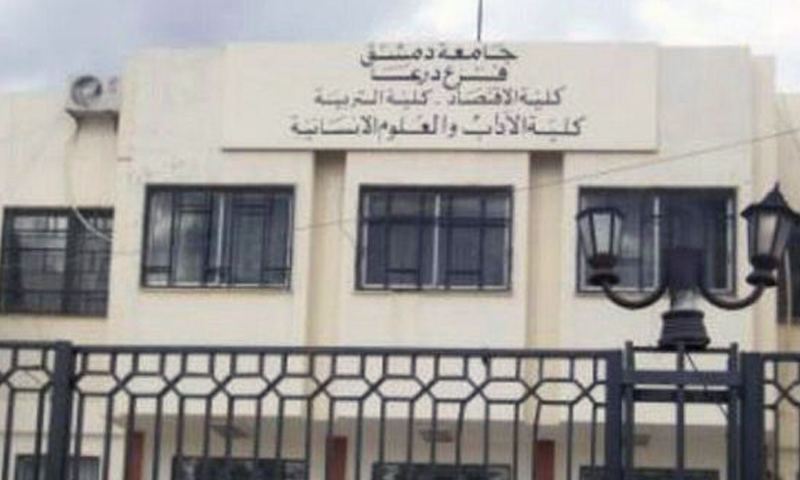Daraa – Halim Muhammad
Shards of glass, rubble, and empty buildings are all that is left of Muzayrib University in Daraa province, southern Syria. While elements of the “Fourth Division” have used the university’s buildings as off-limits military headquarters, its students have become “heavy guests” on other faculty buildings within the University of Daraa.
Muzayrib University is located in the western part of Daraa province, 15 kilometers from the governorate center. Its faculties are affiliated with Daraa University and include the faculty of Arts and Humanities, Veterinary Medicine, Faculty of Agriculture, Law, Sciences, and Economics.
Muzayrib University was opened in 2011; however, two years after the Syrian revolution started, it completely went out of service and was subjected to theft and vandalism.
After the Syrian regime regained control over the southern region in July 2018, the university resumed its educational activity. Nevertheless, its 19,000 students were distributed to the faculties of Education and the Technical, Hotel, and Industrial Institutes, hence government promises of immediate reconstruction and rehabilitation to the university were mere talk with no real efforts on the ground.
Overcrowded classrooms amid Coronavirus spread
Umayma, an Arabic literature student, told Enab Baladi that when she arrived in the Hotel Institute and Tourism Sciences classroom, she was forced to leave due to overcrowding, as she and other students have had a similar problem many times before.
Each classroom can accommodate up to 30 students, but each lecture is usually attended by 150 students, as estimated by Umayma.
Umayma pointed out the health concerns raised by overcrowding, especially with the spread of the novel coronavirus (COVID-19) pandemic, poor ventilation, and the lack of available seats, forcing students to stand up or lean on their knees when they wish to write notes.
The academic year started “after completing the health procedures,” said Dr. Nadim Muhanna, the University of Daraa Colleges’ director, to the “Thawra Online” website last June. Muhanna indicated that students are required to wear protective masks, sterilize their hands, and “avoid overcrowding.”
For Umayma, wearing a mask is not a healthy option, as she said that students are forced to choose between suffering from shortness of breath and dizziness from overcrowding or risking a coronavirus infection.
Since last July, the National Union of Syrian Students (NUSS), Daraa branch, has launched awareness campaigns on coronavirus threats, including distributing masks to students, professors, and employees, disinfecting buildings, and gluing safety brochures.
Nevertheless, social distancing was not applied in the university neither was hand washing due to water cuts since the start of the academic year at the Hotel Institute for Tourism Science.
According to statistics by the Syrian Ministry of Health in mid-October, the number of COVID-19 infected people reached 110 persons, including 66 active infections. However, the news of infection cases and deaths in Syria has prompted international health organizations to question Syria’s reported figures.
Government’s promises of reconstruction and rehabilitation pending implementation
Health risks are not the only problem students face while attending their university lectures, as they are “guests” at the Hotel Institute, whose students attend classes on the top floor.
She added, while the professor gives the lecture and explains the Literary Criticism materials, the garage machinery of the Agriculture Department, which is adjacent to the Hotel Institute from the western side, are working, thus mixing the lecturer’s voice with that of the noise of the machines, with the lack of loudspeakers in the university halls.
“Besides, the windows of the classrooms, where I studied in the past two years, are broken and do not shield the winter cold or the heat of the sun in spring and summer because there are no window curtains,” Umayma said.
According to Umayma, some students complained of the university’s bad situation to the university’s dean, but he answered that there were no solutions except for the return of the university of Muzayrib to work, which is “very expensive” for the state treasury.
According to the assessment of the Technical Committees of Damascus University in 2018, the cost of rehabilitating the university is more than 1 billion Syrian Pounds (SYP = 395,256 USD). This value increased more than five times in two years as the Syrian pound’s exchange rate against the US dollar has risen from around 460 to 2,340 SYP, according to the Syrian Pound Today website in October.
Dr. Abdul Hakim al-Masri, a former lecturer at the University of Muzayrib, said to Enab Baladi that the classrooms are not fit for lectures and have “many deficiencies.”
Al-Masri, who is currently the minister of economy of the Syrian Interim Government (SIG) in northern Aleppo countryside, said that Muzayrib University and its faculties were constructed “temporarily.”
He added that it has an area of 500 dunums (500,000 square meters) and a suitable location for the people of the region with transportation availability.
Al-Masri attributed the fact of no restoration of Muzayrib University for several reasons, the most important of which is the Syrian regime’s current suffering of a “severe shortage of financial resources, as it focuses on financing its military, and then other sectors according to their importance.”
Besides, the regime considers Daraa as “somewhat out of its control,” so it has not undertaken any rehabilitation work for it, not even part of it, al-Masri said.
He added that the regime never forgot that the Daraa governorate was the Syrian revolution’s birthplace and always wanted to punish its residents.

